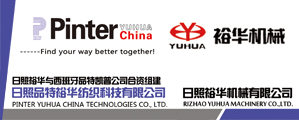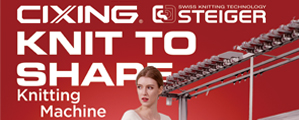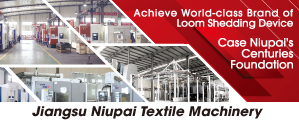Status quo of China’s textile machinery industry in 2017
Mar 27, 2018 | by Source from China Textile Machinery Association

Economic benefits
Industry scale
In 2017, the revenue from main business of the textile machinery industry reached 114.927 billion yuan, up 9.64% year on year and 9.13 percentage points over the same period of the previous year. The total assets amounted to 106.798 billion yuan, up 10.48% year on year and 8.68 percentage points over the same period of last year. The fixed assets investment was 26.403 billion yuan, down 11.96% year on year.
Industry scale
In 2017, the revenue from main business of the textile machinery industry reached 114.927 billion yuan, up 9.64% year on year and 9.13 percentage points over the same period of the previous year. The total assets amounted to 106.798 billion yuan, up 10.48% year on year and 8.68 percentage points over the same period of last year. The fixed assets investment was 26.403 billion yuan, down 11.96% year on year.
Cost structure
In 2017, the textile machinery industry saw total cost of 107.139 billion yuan, an increase of 8.78% year on year, of which: the main business cost was 96.501 billion yuan, a year-on-year growth of 9.20%, while the main business cost accounted for 90.07% of the total cost; operating expenses increased by 9.63% year on year to 3.278 billion yuan which accounted for 3.06% of the total cost; the management costs saw a year-on-year growth of 2.89% to 6.251 billion yuan which accounted for 5.83% of the total cost; the financial costs increased by 5.13% year on year to 1.108 billion yuan, accounting for 1.03% of the total.
Benefits
The textile machinery industry witnessed a total profit of 8.363 billion yuan in 2017, up 23.11% over the same period of last year. The loss of the enterprises running under deficit was 338 million yuan, down 47.74% year on year and the scale of losses reached 11.37%.
Investment in fixed assets
In 2017, the textile machinery industry achieved totaled fixed assets investment of 26.43 billion yuan, down 11.76% year on year, respectively lower than the manufacturing sector (4.8%) and the textile industry (5.21%).
Operation of key enterprises
In 2017, China Textile Machinery Association made a survey of key enterprises, showing that the total income of the main business was 40.195 billion yuan, up 7.51% year on year and 5.88 percentage points compared with the same period of last year, accounting for 42.39% of the total textile machinery industry. The total profit reached 5.799 billion yuan, a decrease of 2.38% year on year, accounting for 85.53% of the industry. Of which, the loss lowered 35.92% year on year to 39 million yuan, while the scale of loss reached 13.64%. The total cost of key enterprises was 40.5 billion yuan, an increase of 1.47% over the same period of last year. The cost of main business was 32.235 billion yuan, an increase of 9.07% year on year, accounting for 79.40% of the total cost. The operating expenses increased 11.03% year on year to 1.684 billion yuan, accounting for 4.15% of the total; management fees decreased by 14.82% year on year to 5.468 billion yuan, accounting for 18.20% of the total cost; financial expenses increased by 20.21% year on year to 1.212 billion yuan, accounting for 2.99% of total cost. The total cost of the financial expenses saw a relatively large growth rate year on year, and the key enterprises are still suffering significant pressure on manufacturing costs.
Imports and exports
According to the Customs, the import and export of China’s textile machinery were totaled 6.965 billion U.S. dollars in 2017 with a year-on-year increase of 25.47%. Specifically speaking, the exports increased by 15.41% year on year to 3.439 billion U.S. dollars, while the imports amounted to 3.526 billion U.S. dollars, soaring 37.13% year on year. Table 1 reflects the import and export of China’s textile machinery.
Table 1 Total Imports and Exports of China’s Textile Machinery, 2017
|
|
|
|
(Unit: USD) | |
|
|
Total Volume |
Total Value |
Y/Y Volume (%) |
Y/Y Value (%) |
|
Total Imports and Exports |
35,512,106 |
6,964,715,388 |
41.32 |
25.47 |
|
Of them: Imports |
3,090,306 |
3,525,714,613 |
51.34 |
37.13 |
|
Exports |
32,421,800 |
3,439,000,775 |
40.44 |
15.41 |
Imports
The total imports from 61 countries and regions in 2017 are totaled 3.526 billion U.S. dollars, an increase of 37.13% year on year.
l Imports of textile machinery products
In terms of imported product categories, imports of auxiliary equipment and spare parts came in the first place, with total imports of 834 million U.S. dollars, up 42.04% year on year, accounting for 23.66% of the total. All seven kinds of products showed a double-digit growth, while the auxiliary equipment and spare parts, spinning machinery, chemical fiber machinery and nonwovens machinery rose higher than the industry average. See Table 2.
Table 2 Imports of Textile Machinery Products, H1, 2017
(Unit: USD, %)
|
Products |
Total Amount |
Proportion |
Y/Y Value |
|
Total |
3,525,714,613 |
100.00 |
37.13 |
|
Auxiliary equipment and spare parts |
834,104,013 |
23.66 |
42.04 |
|
Spinning machinery |
747,367,112 |
21.20 |
41.98 |
|
Knitting machinery |
488,610,748 |
13.86 |
21.74 |
|
Dyeing and finishing machinery |
469,408,005 |
13.31 |
27.20 |
|
Weaving machinery |
459,936,897 |
13.05 |
21.59 |
|
Chemical fiber machinery |
400,511,466 |
11.36 |
67.89 |
|
Nonwovens machinery |
125,776,372 |
3.57 |
79.07 |
Table 3 Countries and Regions of Various Textile Machinery Imports
(Unit: USD)
|
Spinning machinery |
Country |
Germany |
Japan |
Italy |
France |
India |
|
Value |
300,083,020 |
258,410,386 |
112,364,518 |
18,033,357 |
14,072,193 | |
|
Chemical fiber machinery |
Country |
Japan |
Germany |
Italy |
Belgium |
South Korea |
|
Value |
225,874,774 |
131,770,351 |
28,030,994 |
4,091,130 |
2,719,211 | |
|
Weaving machinery |
Country |
Japan |
Belgium |
Germany |
Italy |
Switzerland |
|
Value |
184,837,216 |
147,932,016 |
46,244,187 |
44,996,282 |
32,821,167 | |
|
Knitting machinery |
Country |
Japan |
Germany |
Italy |
Switzerland |
United States |
|
Value |
238,808,945 |
162,708,415 |
37,672,120 |
13,991,779 |
13,351,815 | |
|
Auxiliary equipment and spare parts |
Country |
Germany |
Japan |
Italy |
France |
Switzerland |
|
Value |
287,281,068 |
100,190,459 |
79,805,270 |
68,086,448 |
63,542,079 | |
|
Nonwovens machinery |
Country |
Germany |
France |
Italy |
China Taiwan |
Japan |
|
Value |
57,904,477 |
30,555,712 |
10,342,064 |
8,252,295 |
5,472,699 | |
|
Dyeing and finishing machinery |
Country |
China Taiwan |
Italy |
Japan |
Germany |
South Korea |
|
Value |
111,946,316 |
74,817,008 |
65,309,996 |
62,808,548 |
54,189,773 |
l Main countries and regions of textile machinery imports
In 2017, the major countries and regions of textile machinery import were dominated by Japan, Germany, Italy, Belgium and China Taiwan. The top five saw trade volumes of 2.848 billion U.S. dollars, up 38.20% year on year, accounting for 80.77% of the total. (Table 4)
Table 4 Overview of Major Countries and Regions
(Unit: USD)
|
Country or Region |
Total Amount |
Proportion |
Y/Y Value |
|
Total |
3,525,714,613 |
100.00 |
37.13 |
|
Japan |
1,078,904,475 |
30.60 |
57.12 |
|
Germany |
1,048,800,066 |
29.75 |
30.39 |
|
Italy |
388,028,256 |
11.01 |
29.30 |
|
Belgium |
173,101,153 |
4.91 |
39.98 |
|
China Taiwan |
159,061,951 |
4.51 |
8.98 |
|
Other countries and regions |
677,818,712 |
19.23 |
32.82 |
Imports from Japan ranked first, which are amounted to 1.079 billion U.S. dollars, up 57.12% year on year, of which: spinning machinery saw a trade volume of 258 million U.S. dollars, soaring 48.47% year on year.
Table 5
(Unit:USD)
|
Products |
Total Value |
Y/Y Value (%) |
|
Total from Japan |
1,078,904,475 |
57.12 |
|
Knitting machinery |
258,410,386 |
48.47 |
|
Spinning machinery |
238,808,945 |
87.70 |
|
Chemical fiber machinery |
225,874,774 |
191.36 |
|
Weaving machinery |
184,837,216 |
-0.20 |
|
Auxiliary equipment and spare parts |
100,190,459 |
27.78 |
|
Dyeing and finishing machinery |
65,309,996 |
77.64 |
|
Nonwovens machinery |
5,472,699 |
-27.10 |
Imports of textile machinery from the EU accounted for more than 80.00% of total trade volume, while the imports amounted to 1.891 billion U.S. dollars, an increase of 32.61% year on year. Specifically, the auxiliary equipment and spare parts showed a trade volume of 561 million U.S. dollars, up 5.28% year on year, accounting for 29.68%. The details are demonstrated in Table 6.
Table 6
|
|
|
(Unit:USD, %)
| ||
|
Indicators |
Country or Region |
2016 |
2017 |
Y/Y |
|
Total imports |
2,571,091,698 |
352,5714,613 |
37.13 | |
|
Total from EU |
1,425,838,179 |
1890847868 |
32.61 | |
|
Proportion |
55.46 |
53.63 |
-3.29 | |
|
EU Countries |
Chemical fiber machinery |
149,011,252 |
167,290,769 |
12.27 |
|
Spinning machinery |
302,854,857 |
438,909,884 |
44.92 | |
|
Weaving machinery |
169,353,355 |
239,249,042 |
41.27 | |
|
Knitting machinery |
237,723,760 |
205,404,784 |
-13.60 | |
|
Auxiliary equipment and spare parts |
373,383,804 |
561,118,918 |
50.28 | |
|
Nonwovens machinery |
51,076,378 |
105,992,242 |
107.52 | |
|
Dyeing and finishing machinery |
142,434,773 |
172,882,229 |
21.38 | |
|
Proportion of various categories |
Chemical fiber machinery |
10.45 |
8.85 |
-15.34 |
|
Spinning machinery |
21.24 |
23.21 |
9.28 | |
|
Weaving machinery |
11.88 |
12.65 |
6.53 | |
|
Knitting machinery |
16.67 |
10.86 |
-34.84 | |
|
Auxiliary equipment and spare parts |
26.19 |
29.68 |
13.32 | |
|
Nonwovens machinery |
3.44 |
4.08 |
0.65 | |
|
Dyeing and finishing machinery |
8.52 |
8.99 |
0.47 | |
l Overview of import regions in China
30 provinces and autonomous regions all over the country saw different amounts of imports during 2017. Jiangsu, Zhejiang, Guangdong, Shanghai and Shandong provinces and cities ranked the top five, accounting for 78.64% of total imports. Jiangsu Province ranked first with total imports of 1,038 million U.S. dollars, an increase of 41.21% year on year, accounting for 29.25%. Table 7 reflects the import of textile machinery in the top five provinces and cities.
Table 7 Overview of Top Five Regions in Imports
(Unit:USD, %)
|
Province or City |
Total Amount |
Proportion |
Y/Y Value |
|
Total |
3,525,714,613 |
100.00 |
37.13 |
|
Jiangsu |
1,038,297,843 |
29.45 |
41.21 |
|
Zhejiang |
633,981,770 |
17.98 |
19.75 |
|
Guangdong |
592,789,116 |
16.81 |
57.93 |
|
Shanghai |
264,458,645 |
7.50 |
20.60 |
|
Shandong |
243,074,126 |
6.89 |
17.69 |
|
Others |
753,113,113 |
21.36 |
11.02 |
Exports
China’s textile machinery witnessed total exports of 3.439 billion U.S. dollars in last year, an increase of 15.41% year on year. (Table 8)
l Exports of textile machinery products
According to the Customs, in 2017, China’s textile machinery exports are classified as in Table 8.
Table 8 Exports of Textile Machinery Products
(Unit:USD, %)
|
Products |
Total Amount |
Proportion |
Y/Y Value |
|
Total |
3,439,000,775 |
100.00 |
15.41 |
|
Knitting machinery
|
1,041,989,624 |
30.30 |
13.26 |
|
Dyeing and finishing machinery
|
683,860,520 |
19.89 |
15.98 |
|
Auxiliary equipment and spare parts |
620,474,873 |
18.04 |
7.86 |
|
Spinning machinery
|
416,448,166 |
12.11 |
24.73 |
|
Weaving machinery |
361,103,880 |
10.50 |
18.10 |
|
Chemical fiber machinery
|
191,746,979 |
5.58 |
17.46 |
|
Nonwovens machinery |
123,376,733 |
3.59 |
34.06 |
Knitting machinery exports amounted to 1.042 billion U.S. dollars, up 13.26% year on year, accounting for 30.30%, ranking first, followed by dyeing and finishing machinery, auxiliary equipment and spare parts, spinning machinery, weaving machinery, chemical fiber machinery and nonwovens machinery.
l Main trading partners in exports
In 2017, China’s textile machinery were exported to 181 countries and regions, while the top five export countries and regions are shown in Table 9.
Table 9 Overview of Major Trading Partners
(Unit:USD, %)
|
Country or Region |
Total Amount |
Proportion |
Y/Y Value |
|
Total amount |
3,439,000,775 |
100.00 |
15.41 |
|
India |
678,806,967 |
19.74 |
11.55 |
|
Vietnam |
384,132,565 |
11.17 |
15.35 |
|
Bangladesh |
323,645,896 |
9.41 |
-7.63 |
|
Indonesia |
183,033,002 |
5.32 |
25.55 |
|
United States |
169,151,798 |
4.92 |
60.80 |
|
Other countries and regions |
1,700,230,547 |
49.44 |
18.32 |
In 2017, a total of 30 provinces and autonomous regions presented exports of textile machinery, accounting for 79.46% of the total exports. The details are shown in Table 10.
Table 10 Overview of Top Five Regions in Exports
(Unit: USD)
|
Province or City |
Total Amount |
Proportion |
Y/Y Value |
|
Total |
3,439,000,775 |
100.00 |
15.41 |
|
Zhejiang |
859,918,089 |
25.00 |
18.57 |
|
Jiangsu |
830,269,374 |
24.14 |
17.29 |
|
Shasnghai |
416,809,002 |
12.12 |
12.17 |
|
Guangdong |
402,248,282 |
11.70 |
5.07 |
|
Shandong |
223,228,856 |
6.49 |
34.92 |
Table 11 Overview of Exports to the Areas along the Belt and Road
(Unit:USD)
|
|
Total number |
Total Value |
Y/Y Value (%) |
|
Areas along the Belt and Road |
65 |
2,418,879,311 |
13.90 |
|
Proportion |
35.91 |
70.34 |
-1.31 |
|
East Asia |
1 |
1,436,806 |
39.81 |
|
ASEAN |
10 |
791,584,339 |
20.71 |
|
West Asia |
18 |
261,140,923 |
8.93 |
|
South Asia |
8 |
1,183,811,764 |
4.82 |
|
Central Asia |
5 |
92,583,283 |
211.06 |
|
Commonwealth of Independent States |
7 |
53,008,353 |
48.67 |
|
Central and Eastern Europe |
16 |
35,313,843 |
8.74 |
In summary, in 2017, the textile machinery industry benefited from the continuous recovery of the global economy, the stable growth of the domestic macro economy, the overall stable operation of the textile industry, and the recovery of the international and domestic textile market demand, overcoming the unfavorable factors such as the large increase in factor costs. The main business income and profit of the textile machinery industry grew by a large margin, and the import and export trade volume showed a double-digit growth. After the export value of textile machinery products fell slightly in 2015 and 2016, the export value in 2017 reached a record high.
In 2018, the demand for equipment renewal and upgrading in the domestic market of textile machinery will be further released. In the international market, with the accelerated pace of industrial transfer in the textile industry and the steady progress of the “Belt and Road” Initiative, the textile machinery industry is still expected to achieve smooth operation.








